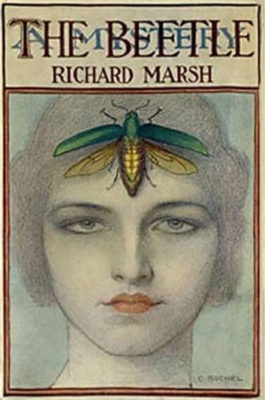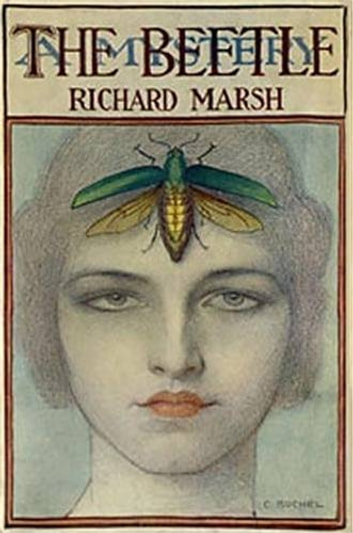General, Night's Black Agents
Call of Chicago: Meet The Beetle
“As he replied to my mocking allusion to the beetle by echoing my own words, he vanished, — or, rather, I saw him taking a different shape before my eyes. His loose draperies all fell off him, and, as they were in the very act of falling, there issued, or there seemed to issue out of them, a monstrous creature of the beetle tribe, — the man himself was gone.”
— Richard Marsh, The Beetle

A horror novel published in 1897 caught the immediate imagination of all England and became an immediate best-seller. Its vile, shape-shifting villain from the unsavory East with an appetite for fair English maidens thrilled readers as much as its shifting viewpoints and plausible air of deniable truth foreshadowed literary modernism. I refer, of course, to the novel The Beetle: A Mystery, by Richard Marsh. Dracula (published two months later) didn’t pass The Beetle in readership until the 1920s, when the play renewed interest in Stoker’s novel – about the same time the relentlessly Edwardian nature of The Beetle finally dropped it into literary obscurity.
Marsh’s novel describes the arrival in London around 1890 (under the name “Mohamed el Kheir”) of one of the “Children of Isis,” a gender- and species-shifting being seeking vengeance on rising liberal politician Paul Lessingham. Lessingham, along with the scientific experimenter Sydney Atherton and the detective son of the Earl of Glenlivet, the Hon. Augustus Champnell, rescues Lessingham’s fiancée Marjorie Lindon from abduction by the Child of Isis, known as “the Beetle.” Although the obliquity with which the novel refuses to make anything clear provides much of its continuing fascination, the basic nature of the titular Beetle seems to be as follows.
The Beetle began as a priestess of Isis, one of the Women of Songs who worship that goddess by human burnt sacrifices and endless orgiastic rites. She defeats death by shifting into the form of a large (foot-long) golden-green scarab beetle, at which point she can shift between beautiful young femininity and a hideous aged male form. For the most part, the Beetle keeps to its grotesque male body in London: small bald skull, pronounced beak of a nose, wrinkled saffron skin, no chin, and luminous yellow eyes stretched wide across its head.
Besides its shapeshifting, the Beetle’s greatest power is mesmerism. It can freeze servants in their paces, entirely dominate a weakened man, and even induce fear, paralysis, or great athletic ability (perhaps even near-flight) by means of post-hypnotic suggestion. If mesmeric power equals command over animal magnetism or elan vital, that may also explain the Beetle’s ability to drain the life-force from men by a kiss, or restore it by the same method, mingling its corrupt breath with that of its victims. Its mesmerism and sexual slavery don’t work continuously or on every subject: the Woman of Songs kept Lessingham drugged to sap his will, while constantly draining his youthful vigor.
The Beetle also proved a cunning psychological warrior, terrorizing and nearly breaking Lessingham with only a burglary and strategically unveiled color pictures of its scarab form. However, its devotion to cult magic (and perhaps its historical memory of ancient Egypt) left it afraid of more powerful arts: Atherton’s electrical apparatus confounded it, and Atherton’s quickness to claim sorcerous skill impelled the Beetle to grovel to him. Even then, it quickly shape-shifted to distract and pause Atherton, escaping in the confusion.
Holy or Haunted Ground
“‘I doubt,’ I said, ‘if this man has been murdered. It looks to me like a case of starvation, or exhaustion,—possibly a combination of both.’
‘What’s that on his neck?’ asked the Inspector,—he was kneeling at my side.
He referred to two abrasions of the skin,—one on either side of the man’s neck.
‘They look to me like scratches. They seem pretty deep, but I don’t think they’re sufficient in themselves to cause death.’”
— Richard Marsh, The Beetle
The Beetle not only shapeshifts and lives for centuries, it also drains the life from at least some of those it encounters: after eerily caressing the bankrupt Robert Holt to faintness, it grows younger and more feminine. The Beetle may drain life by mingling its breath with victims, as again it does Robert Holt. The description of a man it resuscitates through artificial respiration also has vampiric overtones: “There was a rigidity about the muscles of his face, a clamminess about his skin, a disagreeable suggestiveness about the way in which his teeth and the whites of his eyes were exposed, which was uncomfortable to contemplate.”
Here’s a version of the Beetle suitable for Night’s Black Agents or (swapping Magic for Aberrance, etc.) Trail of Cthulhu. The Beetle makes, as the novel shows, a fine standalone villain, or it might be enmeshed in a larger cult of whichever Great Old One lurks behind Isis’ veil, possibly Shub-Niggurath. The bodies of the Children turn out to be “creatures of some monstrous growth,” after all. Other Children of Isis might serve Tera, queen of the mummies (Dracula Dossier Director’s Handbook, pp. 71-72) or work for Edom directly.
General Abilities: Aberrance 11, Hand-to-Hand 3, Health 6, Weapons 2
Hit Threshold: 4
Alertness Modifier: +1 (sensitive smell)
Stealth Modifier: +3
Damage Modifier: -2 (choke, or bite in beetle form)
Armor: -1 (carapace)
Free Powers: Darkvision, Drain
Other Powers: Hold Person (eye contact), Mental Torture (d+1 Stability damage from mental attack), Mesmerism (eye contact, voice, or touch), Shift Gender, Turn to Creature (large scarab), Vile Resuscitation (heal as First Aid, does Stability damage equal to Health restored, victim tainted by the Beetle)
Compulsions: worship Isis
Dreads: sorcery (including sufficiently advanced science)
Requirements: male energy (sexual or otherwise)
In Trail of Cthulhu, seeing the Beetle transform adds a +1 Stability loss to a failed Stability test.
But a Prelude to the Play
As the creature mounted its eyes began to play the part of two small lamps; they positively emitted rays of light. By their rays I began to perceive faint outlines of its body. It seemed larger than I had supposed. Either the body itself was slightly phosphorescent, or it was of a peculiar yellow hue. It gleamed in the darkness.
— Richard Marsh, The Beetle
Or, of course, Isis may be a mask for Cassilda or Camilla or another Carcosan figure. Around 1870, the Isis cult kept a café on the Rue de Rabagas in Cairo, and a cult compound nearby; here they lured Paul Lessingham into their clutches. Only the incursion of Carcosa through the Play allowed the Beetle to operate outside this protective sphere and seek its belated revenge.
In the Yellow King RPG, as in the novel, the Beetle works better as a creepy puppeteer than a combat threat. Solo characters prove most vulnerable to the Beetle: if they fail a Composure test (Difficulty 6) while looking into its eyes, they fall under its mesmeric sway and receive an Enthralled Shock card. After more than a night or two of captivity, the victim also receives the Shock card Unspeakably Tortured, as noted below.
Numbers: 1
Difficulty: Evenly Matched (Escape 3, Other 4, Kill 5)
Difficulty Adjustments: -2 to Escape or Other if combatants wield electrically sparking devices; +2 to Escape or Other if at least one hero has succumbed to the Beetle’s ravishment.
Toll: 1
Tags: Alt
Injuries, Minor and Major: Appalled (Shock)/Throat Punctures
Unspeakably Tortured (Shock): -2 on all tests. Trade (after a month’s kind nursing, or at the end of the scenario) for Post-Traumatic Canthariphobia.
Post-Traumatic Canthariphobia (Shock, Continuity): You retain a morbid fear of beetles. Make a Composure test (Difficulty 7) in their presence; even an image of a beetle or the word “The Beetle” imposes a Composure test (Difficulty 5). Discard upon receipt of solid proof that the Beetle has been destroyed.
Night’s Black Agents by Kenneth Hite puts you in the role of a skilled intelligence operative fighting a shadow war against vampires in post-Cold War Europe. Play a dangerous human weapon, a sly charmer, an unstoppable transporter, a precise demolitions expert, or whatever fictional spy you’ve always dreamed of being — and start putting those bloodsuckers in the ground where they belong. Purchase Night’s Black Agents in print and PDF at the Pelgrane Shop.



